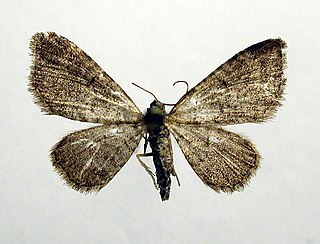 W
WAglais io, the European peacock, more commonly known simply as the peacock butterfly, is a colourful butterfly, found in Europe and temperate Asia as far east as Japan. It was formerly classified as the only member of the genus Inachis. It should not be confused or classified with the "American peacocks" in the genus Anartia; these are not close relatives of the Eurasian species. The peacock butterfly is resident in much of its range, often wintering in buildings or trees. It therefore often appears quite early in spring. The peacock butterfly has figured in research in which the role of eyespots as an anti-predator mechanism has been investigated. The peacock is expanding its range and is not known to be threatened.
 W
WThe Angoumois grain moth is a species of gelechioid moth. It is the type species of its genus Sitotroga, placed in the subfamily Pexicopiinae of the twirler moth family (Gelechiidae). Formerly, it was included in the "Chelariinae", which more recent authors do not separate from the Pexicopiinae and usually even do not consider a distinct tribe ("Chelariini") within them.
 W
WThe codling moth is a member of the Lepidopteran family Tortricidae. They are major pests to agricultural crops, mainly fruits such as apples and pears. Because the larvae are not able to feed on leaves, they are highly dependent on fruits as a food source and thus have a significant impact on crops. The caterpillars bore into fruit and stop it from growing, which leads to premature ripening. Various means of control, including chemical, biological, and preventive, have been implemented. This moth has a widespread distribution, being found on six continents. Adaptive behavior such as diapause and multiple generations per breeding season have allowed this moth to persist even during years of bad climatic conditions.
 W
WCrambus pascuella is a species of moth of the family Crambidae. It is found in Europe.
 W
WEphestia elutella, the cacao moth, tobacco moth or warehouse moth, is a small moth of the family Pyralidae. It is probably native to Europe, but has been transported widely, even to Australia. A subspecies is E. e. pterogrisella.
 W
WEupithecia plumbeolata, the lead-coloured pug, is a moth of the family Geometridae. The species can be found all over Europe ranging to the Urals, then through Central Asia to Siberia and to Sayan mountains, the Altai and the Amur. In the Alps, the species occurs up 2000 metres above sea level and in the Pyrenees up to in 2400 metres.
 W
WNotocelia rosaecolana is a moth of the family Tortricidae. It is found in the Palearctic realm, where it has been recorded from China, Mongolia, Korea, Japan, Iran, Central Asia, Russia and Europe.
 W
WOrgyia antiqua, the rusty tussock moth or vapourer, is a moth in the family Erebidae.
 W
WPyla fusca is a snout moth of the subfamily Phycitinae and inhabits the Holarctic. It is distinct from the other species of the genus Pyla, which are only found in North America, and has been proposed for separation in a monotypic genus Matilella. Considering the insufficient knowledge of Phycitinae, this may be warranted, and eventually relatives of this specimens might be discovered in the Old World, or it might turn out to be a cryptic species complex. On the other hand, its separation might render Pyla paraphyletic, in which case it would not be warranted. More research is required to resolve this question.
 W
WRhyacia quadrangula is a moth of the family Noctuidae. It is found in Iceland, central Asia, the Pamir Mountains, Greenland as well as Canada and the north-western United States.
 W
WScrobipalpa samadensis, the buck's-horn groundling, is a moth of the family Gelechiidae. It is found in most of Europe and Russia.
 W
WThe small tortoiseshell is a colourful Eurasian butterfly in the family Nymphalidae. Adults feed on nectar and may hibernate over winter; in warmer climates they may have two broods in a season. While the dorsal surface of the wings is vividly marked, the ventral surface is drab, providing camouflage. Eggs are laid on the common nettle, on which the larvae feed.
 W
WVanessa atalanta, the red admiral or, previously, the red admirable, is a well-characterized, medium-sized butterfly with black wings, red bands, and white spots. It has a wingspan of about 2 inches (5 cm). It was first described by Carl Linnaeus in his 1758 10th edition of Systema Naturae. The red admiral is widely distributed across temperate regions of North Africa, the Americas, Europe, Asia, and the Caribbean. It resides in warmer areas, but migrates north in spring and sometimes again in autumn. Typically found in moist woodlands, the red admiral caterpillar's primary host plant is the stinging nettle ; it can also be found on the false nettle. The adult butterfly drinks from flowering plants like Buddleia and overripe fruit. Red admirals are territorial; females will only mate with males that hold territory. Males with superior flight abilities are more likely to successfully court females. It is known as an unusually calm butterfly, often allowing observation at a very close distance before flying away, also landing on and using humans as perches.
 W
WVanessa cardui is a well-known colourful butterfly, known as the painted lady, or formerly in North America as the cosmopolitan.
 W
WThe Zeiraphera griseana, the larch tortrix, is a moth of the family Tortricidae.